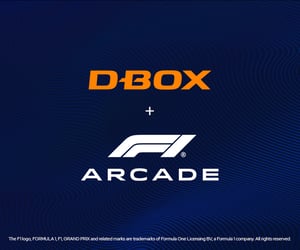Can you explain your role at D-BOX and what it means to be a haptic developer?
My role as a haptic developer is to make sure a game outputs the right telemetry data that I can use to generate haptic feedback that simulates real-life sensations. It means I have to know about physics, digital signal-processing, networking and be really good at math and programming.
For someone who may be new to sim racing, how would you describe what a D-BOX haptic profile is?
A haptic profile is a combination of haptic effects that will make you feel, through your body, that you are in the correct vehicle for the context. For example, with the right haptic profile, you will know you are in an F1 car through haptic feedback alone. It is what makes the difference between the different types of vehicles that can be found through games.
When you start coding a new profile, what’s your process? Where do you begin?
I start by identifying the type of game I will be working on and the vehicles that this game highlights. I then use an already existing profile we made for a previous similar game as a base to build the new experience from.
What makes coding a profile for sim racing different from coding for cinema?
Unpredictability. Unlike a movie where we can know ahead of time what comes next, a game responds to the user in real-time, so we have to anticipate and go through scenarios to ensure that all the effects mix well, that the context stays relevant and that there are no undesired sensations.
Comfort. Though there are settings to adjust effects, there is little room for the haptics to breathe; compared to a movie that has pauses and a set duration. Ensuring the haptic feedback stays comfortable for long unpredictable periods of time all while keeping its realism is important.
Can you walk us through the differences between, for example, an F1 profile and a rally profile?
They have many similarities. Feeling the lateral and longitudinal forces is important, knowing what surface the tire is on (kerb, off track, change of surface) as well. The main difference is in the quantity of surface textures in rally, the bigger suspension movements and the actual jumps. Overall, there are a lot more up-down movements for rally games. Some similar information is interpreted differently, tire slipping in F1 is something we want to catch quickly so it can be corrected. For rally games, slipping is sometimes required for certain sections.
Are there certain details that sim racers might not notice at first, but that make a huge difference for immersion?
A combination of details is what makes the immersion. Use as much of the telemetry available to ensure specific sensations for specific vehicles.
What’s the most challenging profile you’ve ever had to build, and why?
Non-racing: Assassin’s Creed Valhalla – It’s a vast game with many different actions and transportation modes.
Racing: Forza Horizon games – They’re a combination of different racing sports (road, rally, offroad) and all the different surface textures involved, and there’s a large quantity of vehicles (I have to make sure they all feel realistic and accurate).
What’s the most rewarding part of your work when a profile is complete?
Playing the game and enjoying it!
How do these profiles help bridge the gap between sim racing and real racing?
They help develop quick reaction times, you become more sensitive to the effects of the car, and you can feel how a car is supposed to behave on a specific track—so you can focus your eyes and ears on other things.
What do you see for the future of haptic feedback in sim racing?
More precision and detail specific to actual vehicles, I would like to see standardization of telemetry so any game interested can implement a data output to be used by hardware manufacturers and therefore have broader haptic options for the end-user.
If you could give sim racers one insight about D-BOX profiles that people don’t know, what would it be?
We strive to continuously improve the realism of our experiences!
Final thoughts from the track
Haptic profiles might be invisible, but as any sim racer who’s tried D-BOX will tell you, they completely change the way you experience a race. Thanks to D-BOX developers like Félix, every bump, drift, and overtake feels just right—bringing you closer to the real thing with every lap.
So the next time you’re chasing down a podium finish, remember: those perfectly tuned vibrations and movements didn’t happen by accident. They were hand-crafted to make sure you don’t just play the game—you feel it.




